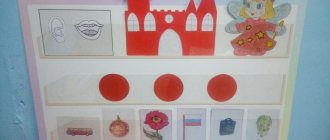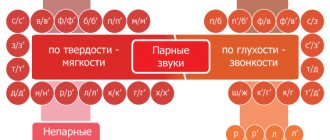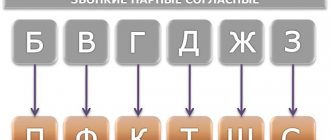Introducing a child to the Russian alphabet is always an encounter with an unknown but mysterious world, in which there are so many interesting things.
The letters of the Russian alphabet make up a whole family, with 33 inhabitants!
And everyone needs to be remembered in their places. But the study of letters does not end there. We also have to divide them into vowels and consonants, stressed and unstressed, soft and hard, voiceless and voiced . And this is still far from a complete classification. Let's figure out how to correctly divide the letters of the alphabet into groups.
Vowels and consonants sounds and letters
First, let's figure out how many letters the Russian alphabet contains. There are 33 of them in total. They are all divided into two large groups: vowels and consonants.
We cannot attribute only the soft and hard signs to any of the groups: they do not denote sound, but serve to indicate the hardness or softness of the previous sound.
Table with cards of vowels and consonants in the Russian language.
Vowel sounds
Vowel sounds are pronounced easily, in a singsong manner. This is possible due to the fact that during articulation in the mouth there is no obstruction to the air flow.
How many vowels are there in Russian? – 10 letters. Vowel sounds are much smaller: only 6: A, O, U, Y, I, E. This difference is explained by the fact that 4 vowel letters are formed by merging two sounds: E=Y+O; E=Y+E; Yu=Y+U; I=Y+A.
Shocked and unstressed
Vowel sounds can be stressed or unstressed. Stressed vowel sounds in a word are emphasized by the voice. Thanks to stress, we understand the meaning of a word. There are words in which the meaning depends only on the placement of the stress, for example: castle- castle. Unstressed sounds are not pronounced so clearly, so in writing we check unstressed sounds with stress.
How many consonants and sounds are there in the Russian language?
There are only 21 consonants, but there are 37 sounds.
Consonant sounds are formed due to an obstruction that occurs in the mouth during the passage of air flow. The role of an obstruction can be played by teeth, tongue, lips; depending on the nature of the obstruction, consonants are divided into many groups, for example, labial, dental, etc.
Consonants are also divided into hard and soft, voiceless and voiced.
Hard and soft
Hard consonants are pronounced more roughly, while soft ones sound more graceful and are softened by a nearby vowel or in writing using a soft sign. In transcription, soft sounds are indicated by an adjacent apostrophe. For example, in the word HOUSE the letter “d” sounds hard, but in the word GO it sounds soft. Soft and hard consonants are presented in the table.
Voiceless and voiced
Voiceless consonant sounds are pronounced without the participation of the voice, while in the formation of hard sounds the participation of the voice is necessary. Voiced and unvoiced sounds, as a rule, form a pair, for example: B-P, V-F, etc. There are only a few sounds that do not have a voiced-voiced pair: Shch, Ts, Y, R, L, M, N.
The table presented on our website will help you fully consider deaf and voiced, hard and soft consonants, as well as stressed and unstressed vowels. It can be hung in the classroom where children have begun to study the Russian alphabet in more detail. It would also be a good idea to hang the chart in a visible place at home if your child is starting to learn letters.
How vowel sounds are formed
“The sounds of voices flow, we read them as we sing.
Letters are called vowels, we can find them in every word.”
Vowel sounds in Russian are formed when a stream of air during exhalation passes freely through the larynx, in which the vocal cords are located. When they are tense, the air causes them to move, to tremble. This is how the sound we hear is created. The vowel sound contains a voice (hence the name - “vowels”, that is, created by the voice). Therefore, you can pull them out, sing: - a-a-a-a-a-a; - oo-oo-oo-oo-oo.
Why are they different? The formation of sounds [i], [s], [o], [u] and others depends on the position of the tongue and lips during articulation.
To pronounce the sounds [o] and [u], you need to stretch your lips forward. Therefore, these sounds are called labialized, rounded. In addition, vowel sounds, depending on the position of the tongue during exhalation and sound formation, are divided into:
- sounds of the front row (the tongue is in the front) - [i], [e];
- sounds from the back row (the tongue is tucked into the back of the mouth) – [o], [u];
- sounds of the middle row (the tongue occupies an intermediate position) - [a], [s].
The second characteristic is lift: high, medium or low rise of the tongue while pronouncing a sound:
- the tongue is raised as far as possible to the palate - sounds [i], [s], [u];
- middle position of the tongue – sounds [e], [o];
- lower – [a].
Tables
What letters represent two sounds?
Say it out loud and when you push out a long stream of air, you will hear:
- I am ['a];
- e is ['e];
- yu- this ['u];
- ё is ['o].
And these letters can also name two more sounds, and therefore they are also called iotized.
Let's try to sing the words: clear, nimble, spruce, hedgehog. What are we doing? Be careful and catch these notes!
Well done! We hear two sounds! Remember guys, this magic happens at the beginning of a word, or if e, e, yu, I comes after a vowel, hard and soft sign.
For example:
- hedgehog – [y'ozh];
- lighthouse - [may'ak];
- eat - [s'y'em].
Letters representing two sounds: e, e, yu, i. They also play a second role: they soften the consonant that comes before them. For example: p' pechka, l' hole, t' warm, t' yuk.
Cartoons on the topic
To help your child quickly learn the division of letters into vowels and consonants, you can offer him cartoons on this topic. On our website you will find educational cartoons dedicated to this topic.
Speech therapist. Russian alphabet
This video presents sounds in the Russian language using examples of onomatopoeia. This technique will allow children to practice the clarity of pronunciation of vowels and consonants, and to more clearly feel the difference in their sound. Sounds accompany bright pictures with animals and natural phenomena. You can watch the cartoon here
Learn and sing the Russian alphabet
This video contains a performance of the alphabet to music. The melody is pleasant, easy to remember, and the song itself is accompanied by a display of the letter and form of its writing. This cartoon can be useful for children of any age, as it is aimed not only at remembering the order of letters, but also at practicing diction. You can watch the cartoon here
Voiceless consonants
There is a generally accepted opinion that it is impossible to sing consonants. However, the authors of this cartoon break the usual stereotypes of perception. Of course, this video cannot be called a song in its entirety: rather, we will be dealing with a drawn-out pronunciation of voiceless consonants. This is extremely useful for children's diction, in which defects in the pronunciation of hissing sounds are constantly visible. Play this cartoon for your child more often so that he corrects his diction. You can watch the cartoon here
Who struck the vowel?
All six vowel sounds can be in a word in stressed or unstressed positions. Their difference is as follows:
- percussive sounds are pronounced more clearly;
- unstressed ones sound less distinct and can act as another phoneme.
This was mentioned above: the sound [and] can appear in speech where other letters appear in the letter. Compare: milk - [m a l a k o]; serpentine – [s'i r p a n t'i n]; all-terrain vehicle – [in' and z d' and x about t].
A strange story happened - in the word milk, the sound [a] is indicated by the letter o in unstressed syllables, and the sound [i] in writing is expressed by the letter e. In stressed syllables such changes do not occur: milkman - [ma l o ch'n' and k ].
In the word milkman, the sound [o] remains under stress; without stress we hear [a]:
milk – milky ([m a la k o]- [m a l o h' n' and k]).
Unstressed sounds cause many difficulties when writing. How to write correctly - herbal or herbal, in the forest or in the fox? For correct spelling, the definition is very important:
To check the correct spelling of an unstressed vowel, you need to change the word so that it is stressed: in the forest - forest, grassy - grass.
Sound analysis of the word
Dear guys, if you were very careful, you saw square brackets and a dash above some sounds. Why is all this needed? The fact is that the spelling and pronunciation of words are different. The pundits thought about how to indicate a sound in writing and came up with the idea of writing it in square brackets. And the checkmark on the upper right side indicates that this sound is soft - it is pronounced differently - more gently. For example, let's say the word "meow". How do we hear it? We write in square brackets: [m'au]. And in the word “fly” - [m] hard.
The recording in the form in which the word is heard is called sound analysis of the word (sound pattern). In high school we will call it “transcription.”
The vowels determine whether the consonant sound is hard or soft.
Remember that if a consonant comes before the vowels e, ё, yu, ya, and, it will be soft.
Vowels - o, e, s, a, u leave the consonant hard.
Exercise
Read the words and make a sound analysis. Try to find soft consonant sounds.
- Baby.
- River.
- Forest.
- House.
Answer: [baby], [r'eka], [l'es], [house].
The difference between vowels and consonants
We already talked about how to distinguish vowels from consonants in the previous lesson. So let's play a little to remember this topic.
There are letters in front of you, try to sing each of them. After this, determine in which carriage the letters live.
Distribute the letters. What is the name of each carriage?
Answer: 1 car – vowel sounds i, u, y, o, a, yu; 2 car – consonant sounds l, b, zh, v.
The main difference between vowels and consonants is the way they are pronounced and formed. Thus, consonants encounter an obstacle in the mouth, but vowels do not encounter obstacles when pronouncing and directing the air flow forward.
Exercise
Practice expressive reading so that you can sing every vowel. Read it to your loved ones and try to cheer them up.
Every child from the 1st grade learns to read and write. To know everything, you need to be diligent. First, learn the alphabet and memorize the vowels and consonants. The ability to read is the most important thing. I love Russian language!
Guys, this concludes our music lesson. Before passing the last test - the test, let's get up and play vowels.





